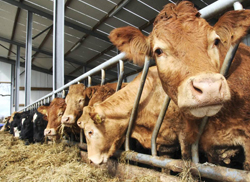
High-yielding animals require a lot of energy to sustain their bodies and produce at the desired level. Many farmers, resort to providing carbohydrate-rich feeds, especially maize, barley, wheat, and oats. In appropriate quantities, grains enhance production. However, too much can be harmful to livestock.
Laminitis
Feeding animals on a diet rich in highly-fermentable carbohydrates such as maize grains increases the chances of laminitis, an inflammatory, non-infectious condition of the foot. Fermentation of the carbohydrates in the rumen leads to production of lactic acid, which induces an acidotic state in the body. This is the main causative factor in the pathogenesis and development of laminitis. Other factors include feet and leg structure, body weight and genetics. Environmental factors such as hard surfaces, poor bedding, and lack or excessive exercise also play a role in the development of this condition.
Clinical signs: Laminitis can occur either as acute, subacute or chronic. The acute form presents very few clinical signs except for swelling feet. The sub-acute form is the more perceptive form, with the most notable signs being soft hooves, yellow colouration of the sole and bleeding stains in the solar area. The chronic form presents typical changes of the hooves. They become more elongated, broadened and flattened. Moreover, there are many grooves and ridges on the wall of the hooves and they appear overgrown. Ulceration and in severe cases separation between the hoof and the skin occurs.
Treatment and control: It is a classic condition where prevention is better than cure. Treatment is difficult once the condition sets in and in most cases; the affected animals are culled. It is, therefore, imperative that the farmer consults with his vet promptly. The most feasible control measure is to ensure the animals are fed on grains at an optimal level. Always have enough forage in the animals’ diet. Hoof health is equally important as well as having concrete floors in the sheds.
The most feasible control measure is to ensure the animals are fed on grains at an optimal level. Always have enough forage in the animals’ diet. Hoof health is equally important as well as having concrete floors in the sheds
Ruminal acidosis
This condition is common in cattle that accidentally gain access and consume large quantities of readily digestible carbohydrates, especially grains. It also occurs in animals when they are introduced to a high grain diet very rapidly. These feeds cause alteration in the rumen bacteria population. The lactic acid makes it conducive for the production of bacteria. This increased production of lactic acid causes the rumen pH to be acidic. This acidotic state is what leads to all the clinical signs manifested.
Clinical signs: Clinical signs range from simple indigestion to fatal illnesses, depending on the amount of grains consumed. Mildly affected animals have an enlarged abdomen, diarrhoea and anorexia (off feed). These animals may get well in a day or two even without treatment. In severe cases, animals stand quietly, get completely anorexic, stagger and some are recumbent. They also have engorged abdomens and profuse diarrhoea.
In severe cases, animals stand quietly, get completely anorexic, stagger and some are recumbent. They also have engorged abdomens and profuse diarrhoea
Treatment and control
Restrict water immediately if you suspect that the animals have consumed large quantities of concentrates even before calling the vet. Severely affected animals are recommended for slaughter as the mortality rate is high even with the most rigorous of treatments.
The vet may empty the rumen of the mildly affected animal either with the aid of a stomach tube or surgery. To prevent this condition, grains and concentrates should be stored safely to prevent animals from breaking in. Further, animals should be introduced to grain and concentrates gradually over a period of about three weeks.
Dr Nderitu Nyaga, works at the Faculty of Veterinary Medicine and Surgery, Egerton University.
